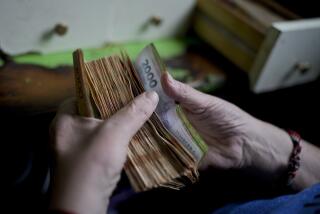Argentine Market Falls 4.6% on Fears
- Share via
MEXICO CITY — Latin American stocks continued to fall Tuesday as officials pushed to defend a new policy on Argentine exchange rates that many feared could lead to a devaluation.
After a decade of pegging its currency, the peso, to the U.S. dollar on a one-to-one basis, Argentina announced late Friday that it was setting up a separate exchange for trade transactions, making imports 7% more expensive. Despite government efforts to spin the new policy as a trade incentive, observers were skeptical, believing that a devaluation was still possible.
In any case, the main Argentine stock index, the Merval, fell 4.6% Tuesday, the first day of trading since the government’s announcement. Bonds rose slightly in value after a huge sell-off in international markets Monday. But Argentina’s overnight inter-bank peso lending rate nearly doubled to 10%.
“The overnight rate is a great barometer of how investors and banks view a country’s sovereign credit risk, and the rise clearly suggests that there isn’t a lot of confidence,” said Jim Luse, a partner in BCP Securities in Greenwich, Conn.
The Argentine switch, which stunned analysts, continued to reverberate in the hemisphere. Mexican stocks fell 2% and Brazilian stocks slumped early in the day, then closed up 0.3%. Brazil’s currency hit a new low of 2.48 to the dollar. The Brazilian real has lost 27% of its value this year.
Brazil is especially vulnerable to Argentina’s problems because the two economies are intertwined. Markets braced for an expected hike in Brazilian interest rates today in a government move to bolster the currency. But the move also could slow Brazilian economic growth and add to the government’s red ink.
Meanwhile, South American presidents meet in Paraguay this week to try to firm up Mercosur, the Southern Cone trade bloc that includes Argentina, Brazil, Paraguay and Uruguay. Argentina’s new exchange policy was widely seen as a blow to Mercosur and as tantamount to protectionism.
In newspaper interviews, Argentina’s finance minister, Domingo Cavallo, blamed some analysts’ “overreaction” for Monday’s sell-off when yields on some government bonds rose by 2 percentage points. Argentine bonds now pay nearly 10 percentage points more in interest than comparable U.S. Treasury bonds, reflecting greater risk.
Some analysts Tuesday agreed with Cavallo, saying the exchange policy, added to tax cuts also announced over the weekend, could well reactivate trade and help generate the economic growth and higher tax collections that Argentina needs if it is to escape a default on its debts in coming years.
Cavallo engineered a $29-billion debt swap earlier this month that eased short-term debt pressures but created even bigger ones in succeeding years.
“This is not a devaluation,” said Omar Borla, senior economist at Santander Central Hispano Investment in New York. “The measures are reasonable and good. Even if their impact is not immediate, they will help domestic demand, exporters and fiscal accounts.”
Analysts believe that Argentina’s shift to the new exchange rate system was prompted by disappointing economic data made public last week, including a 3% decline in May industrial output on a year-over-year basis that indicated the economy is in a deeper hole than feared.
Also reported was a decline in wholesale prices that indicated that Argentina is still in the grips of deflation, said economist David Malpass of Bear, Stearns & Co., not a good sign when the government is trying to pump growth and raise tax revenue.
“We are bearish on Argentina in the long run,” said Lawrence Krohn, economist at ING Barings investment bank in New York. “It’s absolutely imperative that they change a vicious cycle to a virtuous cycle, growing the economy and tax revenues. They aren’t there yet.”
More to Read
Sign up for Essential California
The most important California stories and recommendations in your inbox every morning.
You may occasionally receive promotional content from the Los Angeles Times.













